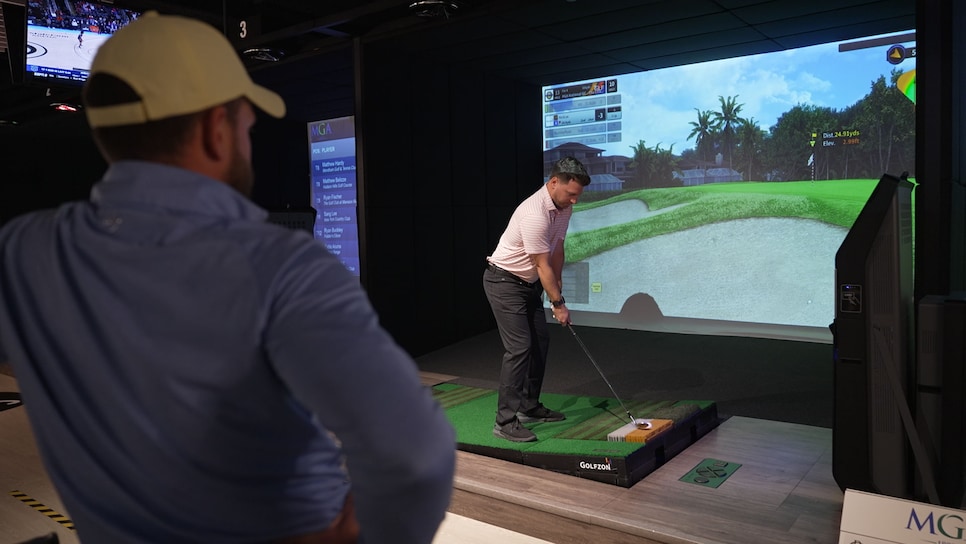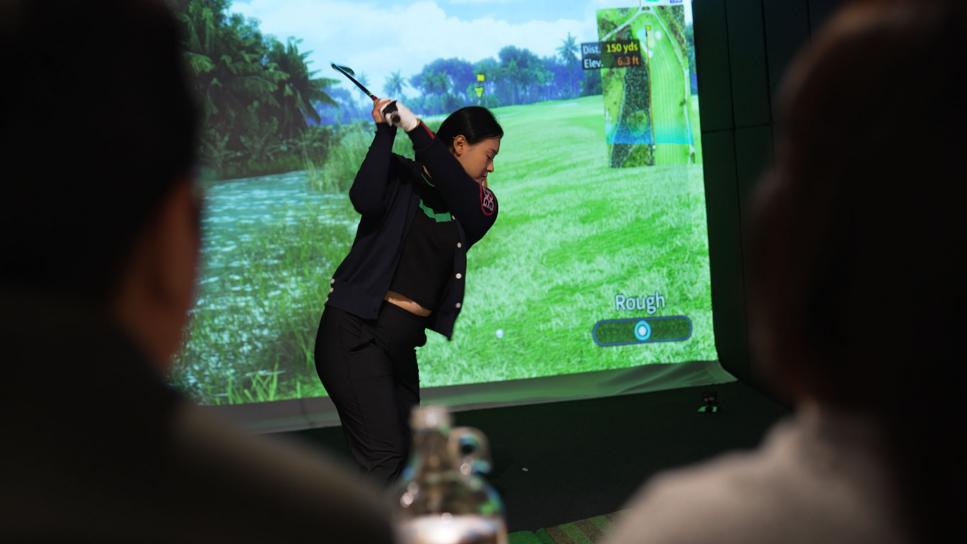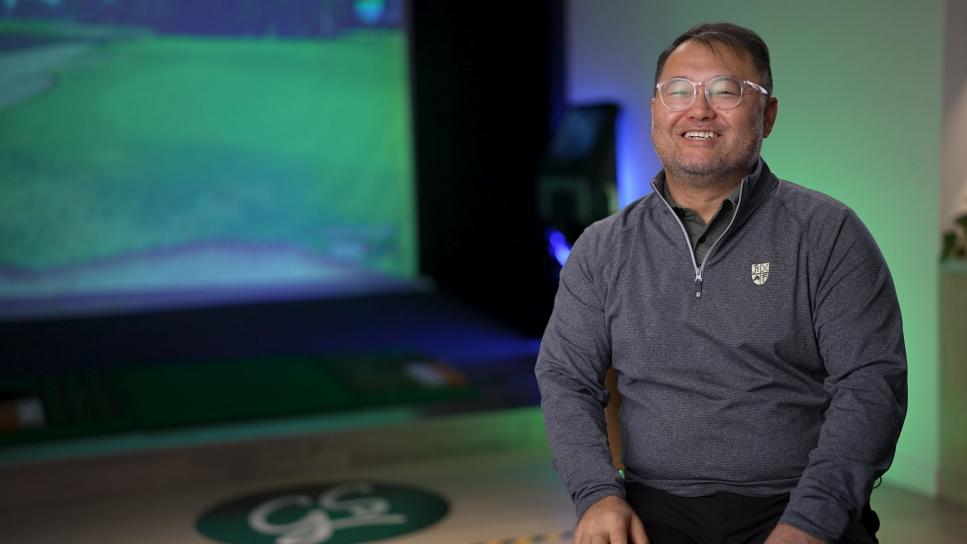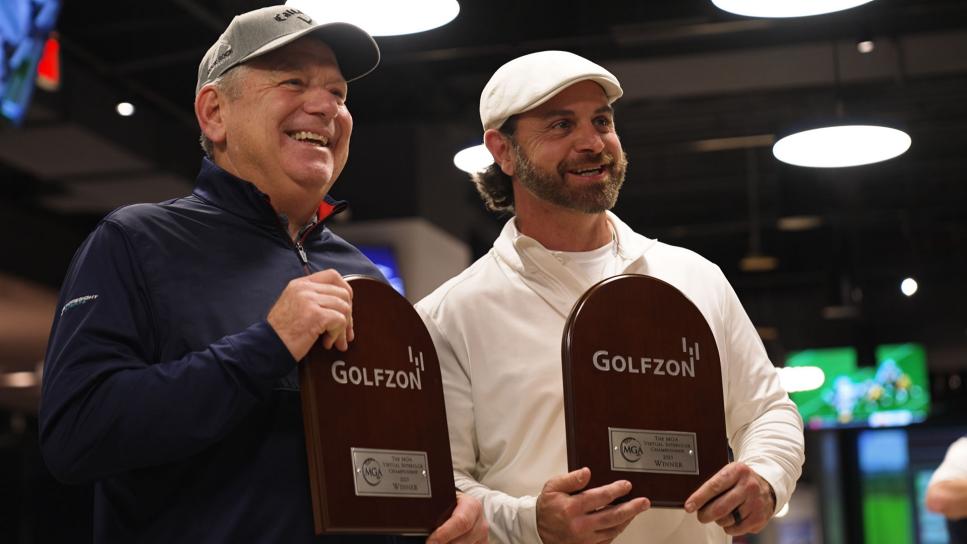Anthony Taylor was the biggest personality in the room, and it was fitting that the tournament’s competitive drama peaked with his bunker shot on the 18th hole. He badly wanted to make eagle on the par 5 at PGA National’s Champion course, and when his second shot flew over the green and into the sand, he made his displeasure clear. Taylor bursts with energy in normal circumstances, and when emotions run high, his voice carries the same power as his swing. He had promised playing partner James McCann, the pro at Spook Rock Golf Course in Suffern, N.Y., where Taylor played, that he would eagle the hole. If he could fulfill the promise, it likely would be enough to guarantee the duo a tournament victory after a scorching back nine. When Taylor calmed down, he stood over his shot, eyed the flag and splashed the ball from the bunker … straight into the hole.
Fireworks ensued, both physical and vocal, and at one point Taylor was so wound up that he said, “I almost feel like I need to punch someone in the face.” He wasn’t serious—I think.
As it happened, McCann was also on the green in two, and made his subsequent eagle putt. Taylor joked to the gallery that he made his first.
Let’s take a breath. As you may have gathered from the title of this article, Taylor and McCann weren’t at the real PGA National, Taylor didn’t hit out of real sand, there was exactly one non-playing spectator and, unlike the players at this year’s Honda Classic, they weren’t competing for millions. This was the Metropolitan Golf Association’s “Virtual Championship,” held on the simulators at Golfzon Social at the Palisades Center Mall on a gray December afternoon in West Nyack, N.Y. Eighteen two-player teams, each consisting of one pro and one amateur and representing clubs from around Westchester County, competed for prizes that weren’t quite PGA Tour purse level, but were significant nonetheless. For winning, McCann and Taylor secured a Golfzon TwoVision simulator and booth for Spook Rock, a value of around $100,000.
More than the prizes, this was a move by Golfzon to establish a vision for what simulator-golf leagues and competitions might look like in America. Founded in South Korea, Golfzon boasts that it is the most popular simulator brand in the world, with 6,200 locations in 62 countries, more than 4 million members and, according to internal numbers, more than 90 million rounds played in 2022 alone. The company is still in its infancy in America, though, and they hope that events like the MGA Virtual Championship will kickstart a growth process that someday turns them into the same cultural phenomenon in the United States.

Teammates Anthony Taylor and James McCann embrace after Taylor’s eagle helped clinch their victory in the Metropolitan Golf Association’s inaugural “Virtual Championship.”
There are a few obvious obstacles to this goal. First, the company has to build a market share from scratch. While having experience growing their brand in Korea, where officials say they control well over half of the market, there is no shortage of competitors with similar ambitions in the U.S. That includes brands like Full Swing—which boasts an ownership team that includes Tiger Woods—not to mention players in the “off course entertainment” space such as TopGolf and DriveShack, as well as local entities serving different metropolitan regions throughout the country.
There are also cultural hurdles. Due to the high population and relatively small landmass in South Korea, and the fact that winter affects the entire country at roughly the same time, simulators are a naturally good business there; in fact, it’s the only country in the world where more rounds are played on a screen than on grass. It’s hard to book a tee time in normal circumstances on the country’s estimated 500-plus golf courses, and the season only runs from March to November. Conversely, Americans can play golf year-round in many parts of the country, which creates a much higher barrier to success for any simulator company.
Still, Golfzon is betting that its technology, along with a commitment to a comprehensive entertainment experience—the West Nyack location included a full bar, restaurant, ping-pong tables, bar shuffleboard and plenty of leather sofas—will distinguish it in a U.S. market that, according to Straits Research, is projected to grow to more than $1 billion by 2030.
Part of the American equation for Golfzon—and how it hopes to distinguish itself from their rivals—is official competition. In Korea, the “GTour” and the women’s GTour pit members against each other in tournaments with purses of more than 70 million won (about $53,000). Golfzon has hosted professional events in conjunction with the KPGA, and the tournaments are broadcast on the Korean Golf Channel and YouTube. The tournament in West Nyack was the first of its kind that Golfzon has hosted in the U.S.—as it is, there are only two Golfzon Social locations in operation, with a third set to open in Brooklyn in 2024—but as a test case, it seemed to prove the point that the “simulator” part of the golf tournament is not an obstacle to what we might call competitive juice. The passion exhibited by the victorious Taylor made the argument; the technology is sufficiently realistic, and the experience sufficiently analogous, to make this feel, if not like “real” golf, then something with equally legitimate stakes.
• • •
Before we get deeper into Golfzon, let’s address a simple question: What is it like to play on these things?
I tested the technology briefly at the Palisades Center, and what struck me initially was the design of the courses themselves. On screen, there is a distinct illustrative quality—we’re not getting into uncanny valley territory here—but the topography of courses like PGA National were still stunning. Everything is mapped with what Golfzon calls “tri-layer videography technology,” and when they tell you that each course takes approximately two months to map using drones, and GPS data, you can believe it. The TwoVision+ model, which I used, has more than 200 courses, while more basic models, sold individually, have fewer.
The next discovery I made is that the ground literally moves beneath your feet; a 24-direction swing plate simulates every kind of lie imaginable, so if your drive comes to rest on the side of a hill, you’re going to have to adjust accordingly. The ball tees up for you automatically on each shot from a hole in the mat, you can adjust your aim (or the height of the tee) with foot pedals. For shots in the rough or the bunker, there are four special mat sections that simulate these lies with surprising accuracy. When your shot hits the screen, you first see the view from behind, a la ShotTracer, but then the angle often changes, and the ball is tracked in its flight as if by a drone (aesthetically, this is one of the most pleasing elements of the simulators). Putting is accomplished with a clever laser-guided system—you aim the ball at a red LED light at the end of the mat—and this is the one area where, based on my experience and watching the other players, I left convinced it’s significantly easier than on a real course. (While demonstrating the system on camera, I yanked a drive into the water, hit a lousy scooped pitching wedge that went 90 yards, followed with a mediocre pitch—all very realistic—and then saved bogey with a 33-foot putt that never left the hole, which happens to me in real life maybe once per year.)

Golfzon uses technology to simulate uneven lies in hopes of making the screen-golf playing experience as true to outdoor golf as possible.
In all, I found it addicting in a preliminary way; it’s relatively simple to complete 18 holes in an hour, and while the price for renting a bay for that length of time (around $65 to $80 at West Nyack, depending on the time) isn’t insignificant for one person, with a foursome playing a famous course in a couple hours, it becomes reasonably affordable. For me, at least, it wouldn’t quite reach the experience of playing outside, but I never got the sense that was Golfzon’s ambition; for golf addicts seeking their fix when it’s too cold (or, since this is 2023, too hot), or for more casual players who like a social environment and less time commitment, the appeal is obvious. And needless to say, if someone magically gave me one of these to put in my house, I might never leave home again.
The players I spoke to that day, a mixture of old hands and new Golfzon players, were positive in their assessment.
“So far it’s awesome, the mat moves and adjusts to your slope, which is pretty cool,” said Matt Hardy, the pro at Mendham Golf and Tennis Club, and his amateur partner, Michael Reddy, echoed what I felt, which is that the distances seemed accurate.
“It’s a different perspective, and the technology’s so good on this now that it doesn’t feel dissimilar to what you’d see in real life,” said Matthew Belizze, a pro at Hudson Hills Golf Course who has played on Golfzon technology since its first incarnation in Stamford.
“This is actually the best simulator I’ve seen in terms of just stances and even the bunker is kind of a similar process in hitting out of it,” said McCann, the eventual winner of the pro division. His club (Spook Rock) was just days away from starting a men’s winter league at Golfzon. “In the summer, we prefer the green grass,” he said, “but it’s also a way for guys who spend a lot of time together in the summer and are stuck at home all winter, this gets them out and socializing.”

• • •
Tommy Lim was a brand director for Nike who joined Golfzon in 2010 as the company was preparing an IPO. Golfzon was successful enough when it went public the next year that the initial market cap was around $1.4 billion. Lim became the chief marketing officer and was instrumental in establishing a relationship with the KPGA and launching the simulation golf tour in 2013. In that time, Golfzon went from $100 million in annual earnings to $300 million. That was particularly impressive considering they had 6,000 locations, which felt like full saturation in a country as small as South Korea.
Golfzon management began looking for opportunities outside Korea, and it tabbed Lim to take charge of the U.S. market. In 2015, he packed up and moved to America, where for the next 15 months, he lived everywhere from L.A. to Dallas to Chicago to Orlando to New York. In each city, he would stay three to six months, observing how locals spent their leisure time and trying to understand the golf market before attempting to start a business. Golfzon gave him the green light in late 2016, his family moved to the U.S., and his job began in earnest.

Tommy Lim is overseeing Golfzon’s efforts in the United States.
With just two employees at his side (his team is now about 70 strong), Lim started the U.S. operation in January 2017. They acquired the David Leadbetter Academy in 2018, and launched the progenitor of Golfzon Social, called ZStrict, in Stamford, Conn., in 2019—unfortunately for them, just before the pandemic. Still, they learned from this project, and had enough data to approach the club management company Troon about a potential partnership. Tim Schantz, the Troon CEO, loved Lim’s concept, and they formed a joint venture in 2022 in which Golfzon agreed to handle the technology (and kept a 75-percent ownership stake) and Troon the hospitality. They opened the first Golfzon Social in February 2023, the Scarsdale location opened in the summer, and along with the upcoming Brooklyn location, Lim says deals are imminent for other New York City locations.
Just as in Korea, Golfzon Social is only part of the company’s makeup in the U.S. There are dozens of commercial locations featuring their simulators, most of them at bars or other entertainment venues, and they hope that aspect of the business will continue to grow. The biggest difference in America is that, as I witnessed at the Palisades location, there is a greater impetus on heightening the social aspects of the experience; unlike Korea, where the opportunity to play golf sells itself, the prevalence of outside golf opportunities in the U.S. demands a more concerted effort to entertain.

McCann (left) and Taylor collect their winner’s trophies.
• • •
The unknown regarding golf simulators in America today is the pending launch of the TGL golf league, where six teams of PGA Tour golfers will compete against each other using simulator technology from Golfzon competitor Full Swing. Lim said that Golfzon had discussions with TGL, but he told me with a laugh that Woods’ role as co-founder of TGL, combined with his ownership stake in Full Swing, made the negotiation a pretty short one. Still, Lim says he’s looking forward to TGL’s eventual launch—now set for 2025—and was disappointed about the delay from its original 2024 target.
“I’m so excited and optimistic,” Lim said. “It draws people’s attention and then that gives a general education to people. When I did market research in 2015, many people didn’t understand what simulator golf was. ‘Are you talking about the Wii?’ I think TGL will help change the perception.”
In other words, a high tide is expected to raise all ships. Lim is confident enough in his company’s technology to see a massive benefit on the horizon from a general rise in the popularity of simulator golf. With the growth of the sport since the pandemic, both on and off course, opportunities are ripe across the board, and Golfzon hopes to parlay its massive Korean success into a significant American footprint. There’s plenty of work ahead, but as the MGA Virtual Club Championship showed, the appeal of being able to play competitive, realistic golf in a place like New York in December is obvious. Now it’s simply a matter of spreading the word.
• • •
Editor’s Note: Golf Digest is producing a documentary video on this tournament for Golfzon, and Shane Ryan was paid to provide narration and interviews. This article was written separately from that agreement and subject to all Golf Digest editorial guidelines.
This article was originally published on golfdigest.com



